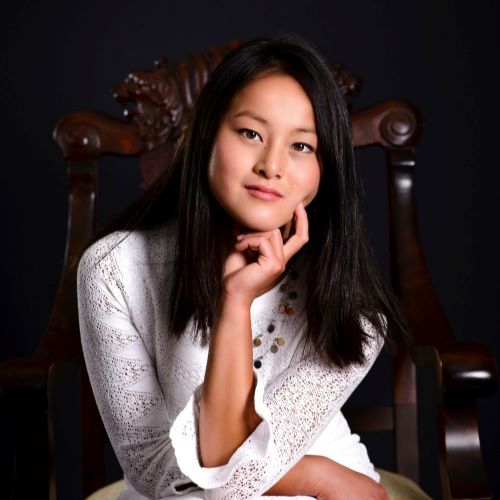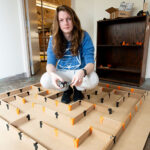
Classics collide in Medici art research with violent themes

Isabelle Hoover ’23 was eager to pursue a senior Independent Study project at The College of Wooster that would marry her majors in art history and classical studies in non-traditional ways beyond looking at ancient art and its ancient sources. When she discovered the Medici family, whose names have become synonymous with the Italian Renaissance, it felt like a perfect way to branch out.
“The Medici were very interested in classical ideas and ways they could translate them into their own lives,” said Hoover. “I became particularly interested in the ways the Medici commissioned art and senses like sound, smell, etc. to create what I called reality spaces in my study.”
“The statuary figures created military realities for visitors, and the family also used these extremely violent themes to justify their violent oppression of enemies.”
—Isabelle Hoover ’23, I.S. title: The Persistent Illusion of the Medici Reality, Mentors: Kara Morrow, associate professor of art and art history, Josephine Shaya, associate professor of classical studies
Much like people can feel transported to a new reality when entering a church like Istanbul’s Hagia Sophia (filled with an ethereal presence, glittering gold, and echoes bouncing off the marble), Hoover argued that the family used art to impress new realities and new histories upon their audiences to essentially legitimize Medici rule.
“The Medici were de facto rulers of Florence in the 15th century, but they were just a banking family,” explained Hoover. “Florence was a republic at the time and was very proud of it, yet, the Medici were essentially princes. It was a very interesting notion to contend with.”
Hoover spent much of her research time at the College libraries analyzing artwork from three key spaces within the the Palazzo Medici: the courtyard with Donatello’s “David” and “Judith and Holofernes” sculptures, the courtyard’s adjoining garden with two antique statues of the flayed satyr Marsyas, and the inner chapel (better known as the Chapel of the Magi) with Benozzo Gozzoli’s series of frescoes depicting the Journey of the Magi to Bethlehem.
In addition to the art, Hoover examined ancient texts such as St. Jerome’s Vulgate translation of the Bible, Plato, Virgil, Cicero, and others. She argued that violence and physical brutality was a primary theme in the Medici courtyard and gardens. “Every text showed these instances occurred within a military context,” said Hoover. “With David and Goliath, the Israelites were fighting, and Holofernes laid siege to Judith’s hometown, so she seduced and beheaded him to save her people.” Additionally, Donatello’s depiction of the “calm hero” David was extremely unusual as it shifted from earlier marble creation (c. 1408-1408) to a more intense bronze sculpture where David appears younger and more gruesome with his foot now resting on Goliath’s head (c. 1440s).
The sculptures of Marsyas the Phrygian Satyr depict him tied to a tree while he’s skinned alive after losing a bet to the god Apollo. “These sculptures stood as beacons of punitive violence for viewers and Apollo served as a figure of divine punishment,” said Hoover. “By challenging the god, Marsyas stood as a threat to divine cosmic order, and as a result, his slaying was not only just it was inevitable.”
Hoover concluded that all the violent artwork created military preeminence for the Medici family in a time when courts generally came to power through family lineage or military superiority. The Medici family had neither. “They had to justify themselves somehow to show they had a right to be in a position of authority,” said Hoover “The art statuary figures created military realities for visitors and the family also used these extremely violent themes to justify their violent oppression of enemies.” When Giuliano de’ Medici was killed in the Pazzi conspiracy (an effort to overtake the family and Florence), his brother Lorenzo went on a murderous rampage to hunt down conspirators and have them all hanged.
Though she didn’t get to travel abroad to see the art firsthand, Hoover did complete two powerful in-person internships. She worked as a 2021 collections intern at the Toledo Museum of Art and as a 2022 Adrienne Arsht Intern in the registrar’s office at The Metropolitan Museum of Art in New York City.
“The Met is the cream of the crop in terms of humanities internships, so I am extraordinarily fortunate that I was able to get that,” said Hoover. “Out of about fifty interns throughout the museum, I was the only intern working on special exhibitions under a team of five registrars.”
Unlike the Medici, there’s no illusion necessary for Hoover, who’s well on her way to creating a vivid career reality. Starting this fall, Hoover plans to pursue a master’s degree in the history of art and architecture at the University of Cambridge. Her dream is to get a Ph.D. in classics, become a professor, and do additional research on her junior I.S. topic of Andromache (Greek mythology’s wife of Hector, the prince of Troy).
Posted in Independent Study on June 12, 2023.
Related Posts
Related Areas of Study
Classical Studies
The languages, literature, history, myths, philosophies, and archaeology of the Ancient Mediterranean
Major MinorArt - Art History
Explore the cultural and historic significance of art and artists while building research and analytical skills.
Major Minor

